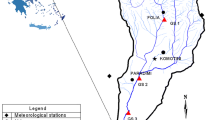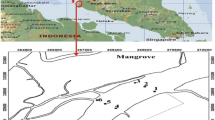Abstract
The usefulness of water quality indices, as the indicators of water pollution, for assessment of spatial–temporal changes and classification of river water qualities was verified. Four water quality indices were investigated: WQI (considering 18 water quality parameters), WQImin and WQIm (considering five water quality parameters: temperature, pH, DO, EC and TSS) and WQIDO (considering a single parameter, DO). The water quality indices WQImin, WQIm and WQIDO could be of particular interest for the developing countries because of the minimum analytical cost involved. As a case study, water quality indices were used to evaluate spatial and temporal changes of the water quality in the Bagmati river basin (Nepal) for the study period 1999–2003. The results allowed us to determine the serious negative effects of the city urban activity on the river water quality. In the studied section of the river, the water quality index (WQI) was 71 units (classified as good) at the entry station and 47.6 units (classified as bad) at the outlet station. For the studied period, a significant decrease in water quality (mean WQI decrease = 11.6%, p = 0.042) was observed in the rural areas. A comparative analysis revealed that the urban water quality was significantly bad as compared with rural. The analysis enabled to classify the water quality stations into three groups: good water quality, medium water quality and bad water quality. WQImin resulted in overestimation of the water quality but with similar trend as with WQI and is useful for the periodic routine monitoring program. The correlation of WQI with WQImin and DO resulted two new indices WQIm and WQIDO, respectively. The classification of waters based on WQIm and WQIDO coincided in 90 and 93% of the samples, respectively.
Similar content being viewed by others
References
APHA–AWWA–WPCF (1995). Standard methods for examination of water and wastewater, 19th ed. Washington, District of Columbia: American Public Health Association, American Water Works Association, Water Pollution Control Federation.
Bordalo, A. A., Nilsumranchit, W., & Chalermwat, K. (2001). Water quality and uses of the Bangpakong river (Eastern Thailand). Water Research, 35(15), 3635–3642.
Brown, R. M., McClelland, N. I., Deininger, R. A., & Tozer, R. G. (1970). A water quality index: Do we dare? Water and Sewage Works, 117, 339–343.
Canadian Council of Ministers of the Environment (CCME) (2001). Canadian water quality guidelines for the protection of aquatic life: CCME Water Quality Index 1.0, Technical Report. In: Canadian environmental quality guidelines, 1999. Winnipeg: Canadian Council of Ministers of the Environment. http://www.ccme.ca/assets/pdf/wqi_techrprtfctsht_e.pdf.
Chang, H. (2005). Spatial and temporal variations of water quality in the river and its tributaries, Seoul, Korea, 1993–2002. Water, Air, and Soil Pollution, 161, 267–284.
Chapman, D. (1992). Water quality assessment (585 pp.). London: Chapman & Hall (on behalf of UNESCO, WHO and UNEP).
Cude, C. G. (2001). Oregon water quality index: A tool for evaluating water quality management effectiveness. Journal of American Water Resources Association, 37(1), 125–137.
Debels, P., Figueroa, R., Urrutla, R., Barra, R., & Niell, X. (2005). Evaluation of water quality in the Chillan river (central Chile) using physicochemical parameters and modified water quality index. Environmental Monitoring and Assessment, 110, 301–322.
Dojlido, J., Raniszewski, J., & Woyciechowska, J. (1994). Water quality index applied to rivers in the Vistila River Basin in Poland. Environmental Monitoring and Assessment, 33, 33–42.
Horton, R. K. (1965). An index-number system for rating water quality. Journal of Water Pollution Control Federation, 37(3), 300–306.
House, W. A., Leach, D. V., & Armitage, P. D. (2001). Study of dissolved silicon and nitrate dynamics in a freshwater stream. Water Research, 35(11), 2749–2757.
Jonnalagadda, S. B., & Mhere, G. (2001). Water quality of the Odzi river in the eastern highlands of Zimbabwe. Water Research, 35, 2371–2376.
MOPE (2000). State of the environment. His Majesty’s Government Ministry of Population and Environment. Kathmandu, Nepal: Ministry of Population and Environment (MOPE) (June 2000).
MPPW (2003). Optimizing water use in Kathmandu Valley Project. Draft final report, ADB TA 3700 NEP. HMG/Nepal: Ministry of Physical Planning Works.
Ongley, E. (1998). Modernization of water quality programs in developing countries: Issues of relevancy and cost efficiency. Water Quality International, Sep/Oct, 37–42.
Ongley, E. D., & Booty, W. G. (1999). Pollution remediation planning in developing countries: Conventional modelling versus knowledge-based prediction. Water International, 24, 31–38.
Pesce, S. F., & Wunderlin, D. A. (2000). Use of water quality indices to verify the impact of Cordoba city (Argentina) on Suquýa river. Water Research, 34(11), 2915–2926.
Rauch, W., Henze, M., Koncsos, L., Reichert, P., Shanahan, P., Somlyody, L., et al. (1998). River water quality modelling – I. State of the art. Water Science and Technology, 38, 237–244.
Rudolf, A., Ahumada, R., & Pe’rez, C. (2002). Dissolved oxygen content as an index of water quality in San Vicente Bay, Chile (36 degrees, 450S). Environmental Monitoring and Assessment, 78, 89–100.
SAFE (1995). Strategic assessment of Florida’s environment, Florida stream water quality index, statewide summary. online: http://www.pepps.fsu.edu/safe/environ/swq1.html.
Said, A., Stevens, D. K., & Sehlke, G. (2004). An innovative index for evaluating water quality in streams. Environmental Assessment, 34(3), 406–414.
Sanchez, E., Colmenarejo, M. F., Vicente, J., Rubio, A., Garcıa, M. G., Travieso, L., et al. (2006). Use of the water quality index and dissolved oxygen deficit as simple indicators of watersheds pollution. Ecological Indicators doi: 10.1016/j.ecolind.2006.02.005.
Shanahan, P., Henze, M., Koncsos, L., Rauch, W., Reichert, P. Somlyody, L., et al. (1998). River water quality modelling – II. Problems of the art. Water Science and Technology, 38, 245–252.
Somlyody, L., Henze, M., Koncsos, L., Rauch, W., Reichert, P., Shanaham, P., et al. (1998). River water quality modelling – III. Future of the art. Water Science and Technology, 38, 253–260.
Stambuk-Giljanovic, N. (1999). Water quality evaluation by index in Dalmatia. Water Research, 33(16), 3423–3440.
Starker, C., & Abbasid, A. (2006). QUALIDEX – a new software for generating water quality indice. Environmental Monitoring and Assessment, 119(1–3), 201–231.
UNPDC (1999). Final report of conservation and development master plan for Bagmati, Bishnumati and Dhobikhola River Corridors. Kathmandu, Nepal: United Nation Development Committee (UNPDC).
US EPA (1997). Volunteer stream monitoring: A methods manual. EPA 841-B-97-003. Washington, District of Columbia: US Environmental Protection Agency, Office of Water 4503F.
USGS (1974). Methods for collection and analysis of water samples for dissolved minerals and gases. Techniques of water-resources investigations. Washington, District of Columbia: US Geological Survey.
Zandbergen, P. A., & Hall, K. J. (1998). Analysis of the British Columbia water quality index for watershed managers: A case study of two small watersheds. Water Quality Research Journal of Canada, 33, 519–549.
Author information
Authors and Affiliations
Corresponding authors
Rights and permissions
About this article
Cite this article
Kannel, P.R., Lee, S., Lee, YS. et al. Application of Water Quality Indices and Dissolved Oxygen as Indicators for River Water Classification and Urban Impact Assessment. Environ Monit Assess 132, 93–110 (2007). https://doi.org/10.1007/s10661-006-9505-1
Received:
Accepted:
Published:
Issue Date:
DOI: https://doi.org/10.1007/s10661-006-9505-1




